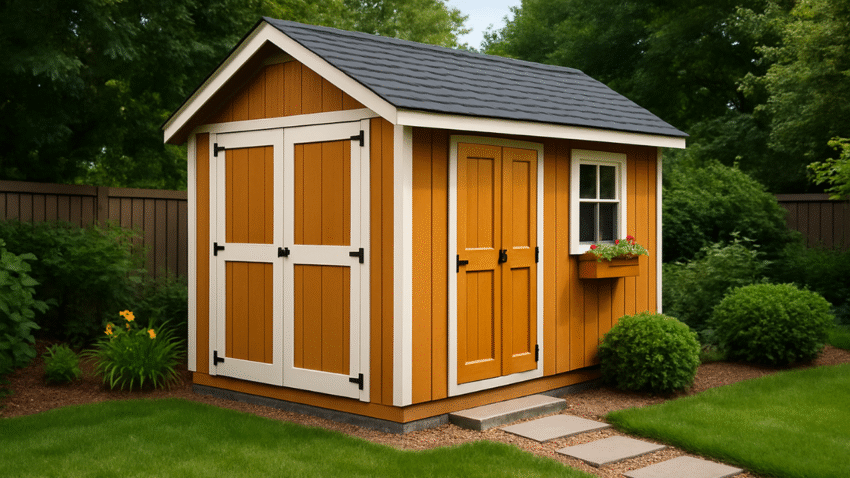Introduction
Choosing the right shed siding materials can make a big difference in your shed’s durability, appearance, and maintenance needs. The siding you pick not only protects your shed from the elements but also enhances its overall look. Many shed owners struggle with deciding between options like wood, vinyl, or metal, especially when considering cost, upkeep, and longevity. This guide will help you understand how to choose shed siding materials that best suit your needs and budget.
Why Choosing the Right Siding Matters for Your Shed
The siding you select plays a crucial role in protecting your shed from rain, wind, and pests while improving insulation and overall strength. Quality siding increases your shed’s lifespan, reduces maintenance costs, and boosts curb appeal. Whether you use your shed for storage, a workshop, or a hobby space, the right siding ensures it remains secure and weather-resistant year-round. It’s also a chance to match your shed’s look to your home or garden style, making it a cohesive part of your backyard.
Step-by-Step Guide to Choosing Shed Siding Materials
1. Determine Your Budget
Start by setting a realistic budget for siding materials. Vinyl and metal are often more affordable and low maintenance, while natural wood looks great but may cost more upfront and over time due to upkeep.
2. Understand Your Climate
Choose siding that performs well in your local weather. Wood can warp in humid conditions, while metal is great for rain but can get very hot in sunny areas. Vinyl works well in most climates but may crack in extreme cold.
3. Compare Siding Options
- Wood: Offers a classic, natural look but needs painting or sealing to prevent rot.
- Vinyl: Low maintenance and affordable, with many colors and styles available.
- Metal: Extremely durable and fire-resistant, though it can dent and may be noisier in heavy rain.
- Engineered Wood or Fiber Cement: Combines durability with a wood-like appearance.
4. Check Maintenance Requirements
Think about how much time you want to spend on upkeep. Wood requires regular painting or staining, while vinyl and metal only need occasional washing.
5. Consider Insulation and Durability
Some siding materials provide better insulation than others. If you plan to spend time inside your shed, fiber cement or insulated vinyl panels may be worthwhile. Durability is also important—choose materials that resist pests, rot, and harsh weather.
6. Match Style With Your Home or Garden
Your shed can complement your home’s exterior. Choose colors and textures that blend well with your backyard, whether you prefer a rustic wood look or a sleek modern style.
7. Factor in Installation Options
Decide if you’ll install the siding yourself or hire a professional. Vinyl and metal are often easier for DIY installation, while fiber cement and natural wood can require more expertise.
8. Get Samples Before Buying
Always check material samples to see how they look in natural light in your yard. This prevents surprises once the siding is installed.
9. Choose Quality Over the Cheapest Option
Saving money upfront can lead to more expenses later. Invest in quality siding to ensure your shed lasts for years without frequent repairs.
10. Purchase From a Trusted Supplier
Look for suppliers with good reviews, warranties, and material certifications to ensure you’re getting the best value for your money.
Common Mistakes to Avoid
- Mistake 1: Picking the cheapest siding available.
Solution: Balance cost with durability to avoid constant repairs and replacements. - Mistake 2: Ignoring climate factors.
Solution: Choose materials that withstand your local weather to prevent rot or cracking. - Mistake 3: Forgetting about maintenance.
Solution: If you want low upkeep, avoid wood unless you’re willing to paint or seal it regularly. - Mistake 4: Not planning for installation.
Solution: Check whether DIY installation is realistic or if professional help is needed. - Mistake 5: Overlooking aesthetics.
Solution: Select colors and styles that complement your home and garden.
Extra Shed Tips & Hacks
- Consider pre-finished siding to save time on painting or staining.
- Use weather-resistant fasteners to prevent rust and extend siding life.
- If you’re building a new shed, install house wrap under siding for added moisture protection.
Check out our guide on how to reinforce shed doors and windows to make your shed even more secure.
Conclusion
Choosing the right shed siding materials is a key step in building or upgrading your shed. By considering budget, climate, maintenance, and style, you’ll find a siding option that protects your shed while enhancing its look. Take your time to compare options and invest in quality for long-term benefits.
Bookmark this guide to help you make the best decision for your shed project!
